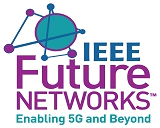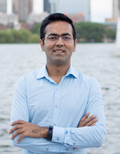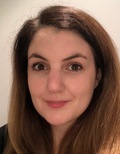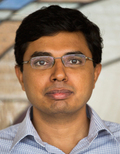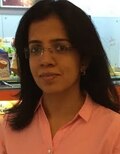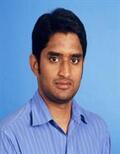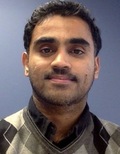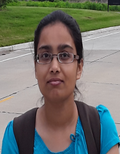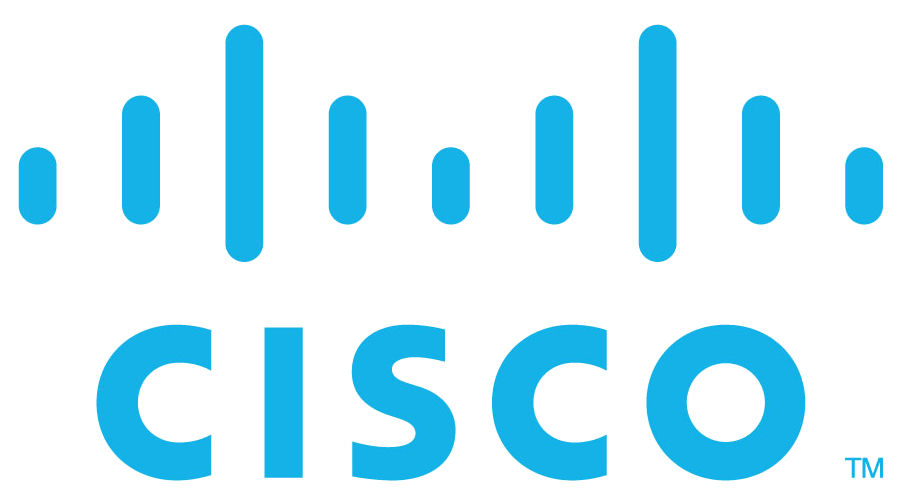Invited Speakers
Dinesh Bharadia
University of California, San Diego, USAVisit Homepage
8th Jan 2021
In the last decade, MIMO spatial multiplexing has promised to increase data throughput by orders of magnitude. However, we are yet to enjoy such improvement in real-world environments, as achieving the capacity of the MIMO channels requires rich scattering and preclude effective MIMO spatial multiplexing. Furthermore, the gains are limited by scattering of the environment rather than MIMO antennas.
In this talk, I would present ScatterMIMO, which uses smart surface to increase the scattering in the environment, to provide MIMO spatial multiplexing gain. Specifically, the smart surface pairs up with a wireless transmitter device say an active AP, and re-radiates the same amount of power as any active access point (AP), thereby creating virtual passive APs. ScatterMIMO allows the smart surface to provide spatial multiplexing gain, which can be deployed at a very low cost. Furthermore, ScatterMIMO can provide signals to their clients with power comparable to real active APs, and can increase the coverage of an AP. Furthermore, we design algorithms to optimize ScatterMIMO’s smart surface for each client with minimal measurement overhead, provides a median throughput improvement of 2x over the active AP alone.
Dinesh Bharadia is Assistant Professor at UC San Diego, where he leads the wireless communication sensing and networking group (WCSNG). His research interests include advancing the theory and design of modern wireless communication and sensing systems, and low-power networks. In recognition of his research, he was named a Marconi Young Scholar for outstanding wireless research and awarded the Michael Dukkakis Leadership award. He was also named as one of the top 35 Innovators under 35 in the world by MIT Technology Review in 2016 and worldwide Forbes 30 under and 30 for Science category in 2018.
He received his Ph.D. in the Electrical Engineering Department at Stanford University. His Ph.D. thesis invalidated a long-held assumption in wireless communication by building full-duplex radios. From 2013 to 2015, he was a Principal Scientist for Kumu Networks, where he worked to commercialize his research on full-duplex radios, building a product which underwent successful field trials at Tier 1 network providers worldwide like Deutsche Telekom and SK Telecom. He received his bachelor's degree in Electrical Engineering from the Indian Institute of Technology, Kanpur in 2010. He is a recipient of the Stanford Graduate Fellowship, as well as a gold medal at IIT Kanpur for graduating at the top of his class. His research has been published at top conferences like SIGCOMM, NSDI, MobiCom, etc and has been cited over 6500 times (Google Scholar).
Andra Lutu
Telefonica Barcelona, SpainVisit Homepage
7th Jan 2021
There are certain factors that render the cellular ecosystem complex and obfuscate the relationships between different networks and carriers, including the use of IP Exchange (IPX) providers that enable roaming partnerships or the presence of international carriers that sell connectivity services to vertical industries and connected machines across different countries. In this talk, I will try to shed light onto the structure of the cellular ecosystem and analyze the implications and exploitation of one of its fundamental features: international roaming. “Roam like Home” is the recent initiative (June 2017) of the European Commission (EC) to end the levy of extra charges when roaming within the European region. As a result, people are able to use data services more freely across Europe. However, the implications roaming solutions have on performance and user quality of experience received little examination. Even more, this infrastructure that mobile operators have established over the last 20 years for person-to-person communications is now being re-purposed to support the IoT expansion and M2M communication. Players across different markets -- from health to logistics -- require reliable connectivity and/or mobility around the world without needing to establish commercial relationships with every operator. We use real-world measurements to offer an in-depth characterization of roaming solutions and their implications in terms of performance or QoE for end-users traveling in Europe. We then focus the analysis on characterizing roaming for M2M/IoT communications. By combining the view from an operational M2M platform with that from an operational MNO in the UK, we shed light on the breadth of M2M/IoT platforms and the impact they have on visited MNOs.
Andra Lutu is an Associate Researcher at Telefonica Research in Barcelona, Spain. Her main research interests lie in the areas of network measurements, interdomain routing and mobile networks. After receiving her PhD at UC3M and IMDEA Networks Institute in Spain, Madrid, she worked as a Postdoc Fellow at Simula Research Laboratory, where she was a main contributor to the H2020 MONROE project, building the first open European hardware infrastructure to perform measurements in operational mobile networks. As part of Telefonica Research, Andra is a recipient of an H2020 MSCA Individual Fellowship grant funding her work on Dynamic Interconnections for the Cellular Ecosystem (DICE).
Harsha Madhyastha
University of Michigan, USAVisit Homepage
7th Jan 2021
Popular web services are often deployed across data centers in multiple regions in order to deliver low latency and high availability to users. In such global-scale deployments, service providers face several fundamental tradeoffs. For example, replicating data at all locations enables low latency reads, but at the expense of high storage and wide-area bandwidth costs. Similarly, a cloud provider is forced to choose between offering predictable bandwidth to tenants by statically reserving capacity versus maximizing the network's utilization by dynamically redistributing bandwidth among tenants.
In this talk, I will present some of the recent work in my group towards addressing the above-mentioned tradeoffs. In the context of geo-distributed storage, I will present Pando, our new approach for consensus across the wide- area network which does not merely improve upon the status quo, but achieves near-optimal latency versus cost tradeoffs. I will also discuss HEYP, our new architecture for global software-defined wide-area networks which simultaneously enables bandwidth predictability and high network utilization.
Harsha V. Madhyastha is an Associate Professor in Computer Science and Engineering at the University of Michigan. His research interests span all facets of scalable, fault-tolerant, performant, and privacy-preserving networked systems. His work has resulted in award papers at several top-tier conferences and also received the IRTF's Applied Networking Research Prize on multiple occasions. He is the recipient of Google Faculty Research awards, a NetApp Faculty Fellowship, a Facebook Faculty Award, and an NSF CAREER award.
Sharayu Moharir
IIT Bombay, IndiaVisit Homepage
7th Jan 2021
The focus of this work is on the benefits of using storage/computation resources at the edge to host Software as a Service (SaaS) instances like social networks, online shopping, navigation services etc. A key characteristic of current edge computing platforms is the pay-as-you-go flexibility via short term contracts. The client can thus optimize the cost incurred to edge resources by dynamically adjusting hosting decisions depending on request patterns. Unlike most of the existing literature on this topic, where the SaaS is either completely hosted at the edge or not hosted at all, we allow the service to be partially hosted at the edge. This is motivated by the growing popularity of the paradigm of designing services as a collection of independent microservices instead of a monolith.
In the setting where edge resources can be rented and the SaaS can be partially hosted at the edge, we first characterize the fundamental limit on the performance of any policy. We propose an online hosting policy which dynamically determines what fraction of the SaaS is hosted at the edge based on the request arrival process and the various costs involved in an online manner. We corroborate our analytical results by comparing the performance of the proposed policy and some natural alternatives like TTL via trace-driven simulations using real-data.
Joint work with Mohit Agarwala, Lakshmi Narayana, and Nikhil Karamchandani.
K P Naveen
IIT Tirupati, IndiaVisit Homepage
6th Jan 2021
K. P. Naveen received the B.E. degree in Electronics and Communication Engineering (ECE) from the Visvesvaraya Technological University, Belgaum, in 2005, and the Ph.D. degree from the Department of Electrical Communication Engineering, Indian Institute of Science (IISc), Bangalore, in 2013. Subsequently, he worked as a post-doctoral fellow at INRIA Saclay, France (Jan. 2014 - Dec. 2015), and then as an INSPIRE Faculty at the Department of Electrical Engineering, IIT Madras (Jan. 2016 - July 2017). His work experience also includes Scientist-C at the ISRO Satellite Centre, Bangalore (Jan. 2006 - July 2007). Since July 2017 he has been working as an Assistant Professor at the Department of Electrical Engineering, IIT Tirupati. His research interests include modeling and performance analysis of wireless networks, network economics, game theory, and optimal control.
Damith Ranasinghe
University of Adelaide, AustraliaVisit Homepage
8th Jan 2021
I will share a brief overview of our recent activities towards addressing two of the grand challenges in multi-agent systems: i) using a team of agents for tasks; and; ii) navigation and exploration for autonomy with a focus on engineering demonstrable prototypes. In this context, I will focus on the challenging problem of online planning for a team of agents to autonomously achieve competing objectives. I will use searching and tracking a time-varying number of mobile objects under the practical constraint of detection range limited on-board sensors to discuss the topic. Currently, to the best of our knowledge, a theoretical formulation for a multi-agent system for simultaneously meeting the conflicting goals of searching for undiscovered mobile objects whilst keeping track of discovered objects does not exist. In addition to the challenges posed by tracking multiple targets, the navigation problem is further complicated by misdetections or false detections of objects caused by range limited sensors and noise inherent to sensor measurements, while controlling multiple agents is a well-known combinatorial optimization problem. I will provide an overview of our work to tackle these problems and illustrate how the general framework and the problems explored are applicable to FANETs (Flying Ad-Hoc Networks) in dynamic settings.
Damith Ranasinghe is an Associate Professor at the Computer Science, University of Adelaide and leads a research group of around 20 members. His recent work funded by the Australian Research Council (ARC) focuses on using teams of autonomous drones for improving situational awareness by enabling tasks such as target tracking and discovery. His recent studies in the field are published in venues such as the Journal of Field Robotics, IEEE Transactions on Signal Processing and the prestigious AAAI Conference on Artificial Intelligence.
Winston Seah
Victoria University of Wellington, New ZealandVisit Homepage
7th Jan 2021
Internet Service Providers need to deploy and maintain many wireless sites in isolated or inaccessible terrain to provide Internet connectivity to rural communities. Addressing failures at such sites can be very expensive, both in identifying the fault, and also in the repair or rectification. Data monitoring can be useful, to spot anomalies and predict a fault (and possibly preempt it altogether), or to locate and isolate it quickly once it causes an issue for the network. There might be hundreds of variables to be monitored in principle, but only a few of significance for detecting faults. Here, in a case study involving a Wireless Internet Service Provider (WISP) in a rural area, we first illustrate a bottom-up approach to the identification of variables likely to be of use in an automatic anomaly detector. For the purpose of this study, the detector consists of an autoencoder neural network with weights optimized by machine learning (ML). We then show how the cause of an anomaly can be derived from indirect measurements, and use the model to learn relationships between certain variables.
Karthik Sundaresan
NEC Labs, USAVisit Homepage
7th Jan 2021
Advances in mobile (cellular) networks have ushered in an era of abundant connectivity. However, the stationary and expensive nature of their deployment has limited their ability to provide true "ubiquitous" connectivity under the 5G vision - especially to areas where connectivity is sparing or nonexistent (e.g. rural areas), has been compromised (e.g. disasters), or demands are extreme (e.g. venues/hotspots).
The recent advances in un-manned aerial vehicle (UAVs) technology have the potential to change the landscape of wide-area wireless connectivity by bringing a new dimension - "mobility" to the cellular network infrastructure itself. By deploying base stations on each of the UAVs, service providers can now deploy and tear-down these cellular networks "in the sky" in an on-demand and flexible manner. This allows them to supplement static mobile networks in areas where additional connectivity is needed, or provide stand-alone connectivity in areas where existing mobile networks are either absent or compromised. However, realizing this vision of deploying heavy-weight cellular networks (e.g. LTE) on light-weight, resource-constrained platforms such as UAVs, faces several formidable challenges both in design and deployment. This is complicated by the complex nature of cellular networks that involve multiple interacting components - radio access network (RAN), evolved packet core (EPC) network and backhaul transport network.
In this talk, I will present our system "SkyLiTE"-- one of the first efforts to design and deploy an on-demand, end-to-end, multi-cell LTE network (on UAVs) that can self-configure itself in the sky. I will discuss how SkyLiTE brings together several advances in wireless networking research to re-architect the various components (RAN, core and backhaul) of a cellular network, thereby making it deployable on challenging UAV platforms in highly dynamic environments. The validation of SkyLiTE in real-world deployments shows the potential for contributing to a new era of mobile networks that can fly and make not just connectivity but also sensing ubiquitous.
Karthikeyan (Karthik) Sundaresan is a senior researcher in the mobile communications and networking research department at NEC Labs America. His research interests are broadly in wireless networking and mobile computing, and span both algorithm design as well as system prototyping. He is the recipient of ACM Sigmobile’s Rockstar award (2016) for early career contributions to mobile computing and wireless networking, as well as several best paper awards at prestigious ACM and IEEE conferences. He holds over fifty patents, and received business contribution awards for bringing research technology to commercialization at NEC. He has participated in various organizational and editorial roles for IEEE and ACM conferences and journals, and served as the PC co-chair for ACM MobiCom’16. He is a Fellow of IEEE and an ACM distinguished scientist.
Pooja Vyavahare
IIT Tirupati, IndiaVisit Homepage
7th Jan 2021
In this talk, we consider a general version of opinion dynamics in discrete-time multi- agent networks when interactions among agents are either cooperative (trust) or antagonistic (mistrust). In particular, we study cluster consensus problems wherein agents of the network partition into more than two disjoint sets with non-identical opinions. Structurally balanced networks are well studied in classical opinion dynamics. In the first half of the talk, we will see its extension to cluster consensus problem and propose distributed iterative synchronous update rule to achieve cluster consensus over structurally balanced networks. We will see its extension to asynchronous and time-varying systems. In the second half of the talk, we show that structural balance network is a sufficient but not a necessary condition for achieving cluster consensus. We present sufficient conditions for the system stability and propose a control mechanism to achieve cluster consensus in structurally unbalanced networks.
Dr. Pooja Vyavahare is an Assistant Professor at Department of Electrical Engineering, Indian Institute of Technology Tirupati. Before joining IIT Tirupati, she was a postdoctoral fellow with the Coordinated Science Laboratory at University of Illinois at Urbana-Champaign. She obtained her Ph.D from the Department of Electrical Engineering, IIT Bombay. Subsequently, she was briefly with CSE, IIT Delhi as a postdoc and later at the School of Computing and Electrical Engineering, IIT Mandi as a DST-INSPIRE faculty. Her research interests include distributed function computation and optimization, analysis of communication networks.



